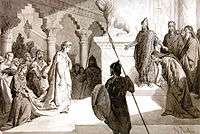Orontes I Sakavakyats
| Orontes I Sakavakyats | |
|---|---|
| King of Armenia | |
| Reign | 570 BC – 560 BC |
| Predecessor | Hrachya |
| Successor | Tigranes |
| House | Van |
| Dynasty | Orontid Dynasty |
Orontes I Sakavakyats was the first Orontid king of Armenia, reigning in the period between 570 BC – 560 BC.
Life
Orontes was called Sakavakyats or "short living" ("short staying"), not because of a short life, but rather because of the short period of his reign, and because he passed the throne to his son Tigranes. Orontes I had 40,000 infantry and 8,000 cavalry, as well as 3,000 talents (40 kg 800g) of silver with the united weight of 122,400 kg. This is based on the real Orontes I who had at least 3,000 talents of silver and the real Orontes II who commanded the right wing of king Darius III army at the Battle of Gaugamela in 331 BC, with 40,000 infantry under his command and 7,000 cavalry. According to popular legends, only half of Orontes I's 3,000 silver talents were part of his treasury; the other part was hidden in the bottom of Van Lake. Through his castle he had a tunnel leading there, but later they blocked the tunnel to save the treasury for future generations. It is still said to be hidden there untouched.
Orontes I's father was Artasyrus and Hrachya is the local Armenian version of Artasyrus' real name, Artakhshathra.[1] He married his daughter Tigranuhi to Medes king Ajdahak (Astyages). The capital of Armenia under Orontes was located in Van.[2]

Xenophon provides an account of his trial before Cyrus the Great in Book 3 of the Cyropaedia.[3]
References
- ↑ Cook, J.M. (1993). The Persian Empire ([Repr.] ed.). New York: Barns & Noble Books. pp. 170, 173, 193, 212, 213, 216, 217, 221–223, 257, 263. ISBN 1-56619-115-7.
- ↑ Khachatri︠a︡n, Aĭsh (2006). 141 Kings of the Armenians. Erevan: Amaras. ISBN 978-99930-1-192-7
- ↑ http://www.perseus.tufts.edu/hopper/text?doc=Xen.%20Cyrop.%203.1&lang=original#note-link2
